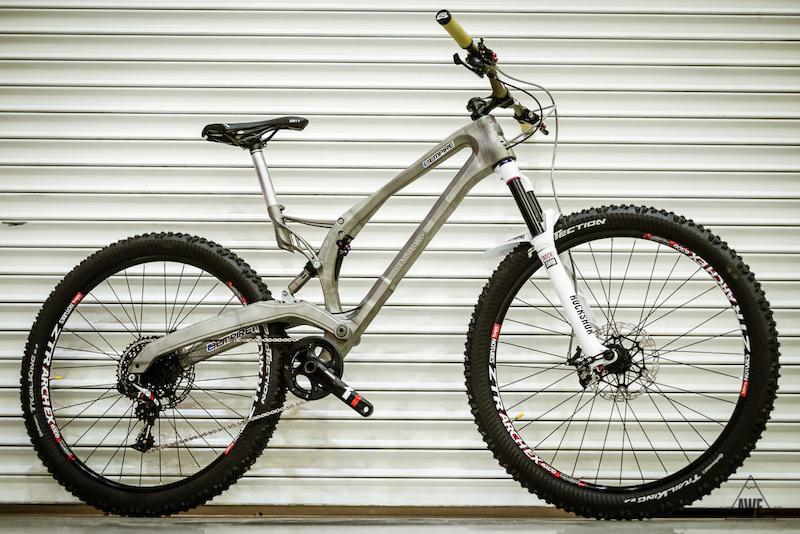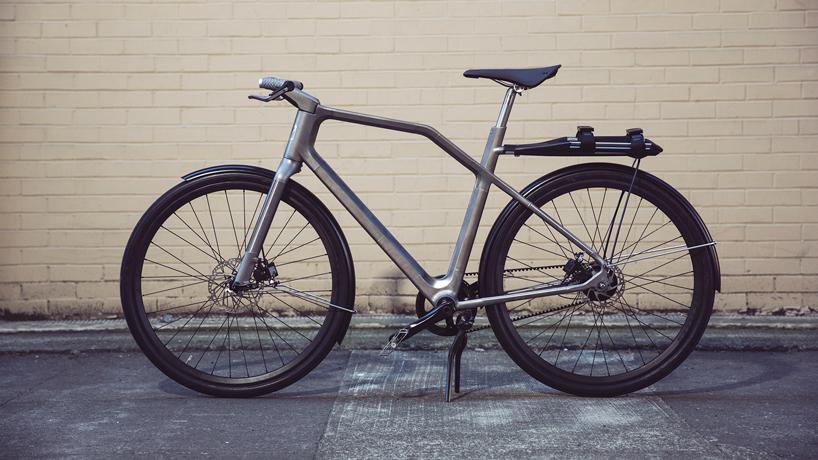In 2011 Bristol engineers announced the creation of 3-D printing bicycle made from nylon. In 2012, UK bike brand, Charge Bikes announced the development of the first ever production printed titanium bicycle parts. Printing these parts, as opposed to machining them, allowed them to create pieces with greater complexity than would otherwise be possible. In addition, it was quickly realized that among the benefits of using additive manufacturing to create bicycle components was a significant reduction in the amount of material required to produce them.
For many cyclists titanium is the material of choice because of its elongation, tensile, and fatigue strength. However, while titanium is the fourth most abundant metal on the planet, it still has a relatively high cost. There are two main reasons why titanium comes with a big price tag: the cost of its extraction and the cost of its processing. While 3-D printing does not impact the cost of extraction, it significantly changes the requirements for its processing. The realization of this potential for additive manufacturing technologies to lower the cost of a highly desirable product has led to a slew of innovative 3-D printed titanium cycling projects.
In February of 2014, a 3-D printed titanium trail bike on show at the London Bike Show, printed by Empire, made headlines. While the model produced for display was not rideable it represented the first time that a complete titanium bicycle frame was built using 3-D printing. Chris Williams, bike engineer at Empire, explained the forward-looking nature of this foray into printed titanium:
“What I’ve done here is rather than building a small component that fits into the build area many times, I’ve taken large components and broken into smaller pieces to fit into the build area. I think we’ll see more of this in the future. This is the very forefront of it, because I started this project six months ago, and the other week Renishaw told me that if I approach than six months earlier, they would have had to decline the project. It’s such cutting edge technology.”
This brings us to the current state of titanium by creation, with a model named Solid. In collaboration with Ti Cycles, the Portland-based design consultancy INDUSTRY announced this week the creation of the first connected 3-D printing titanium bike. Ti Cycles has a reputation of being one of the best bicycle builders out there. They hand build custom steel and titanium frames, as well as a wide variety of bicycle components and accessories. They have a full-service welding machine shop and are intimately familiar with traditional and cutting edge bicycle fabrication.
Their newest creation, Solid, builds upon a quarter century of innovation and experimentation. Billed as a “super commuter” platform this bicycle is a titanium frame and subassemblies, the carbon belt drive, and internal geared hub, hydraulic disc brakes, vendors, and internal wiring. This is the kind of list that grabs the attention of those invested in bicycle commuting.
In an interview with 3Dprint.com, competitive cyclist and longtime bike commuter, Pawel Rygulski, discussed his opinion of Solid:
“From a design perspective this is a very well-designed bicycle. I have commuted to work by bicycle for years and I often think about what would be my ultimate commuter bike. I have to say they had nearly hit the bull’s-eye with this design. It contains the exact components I would use if I were to build a commuter bike. The frame design is very clean – for me less is more when it comes to bicycles.”
There is no doubt that this bicycle reflects the beauty of a form that follows its function. Rather than relying on gimmickry, complexity of this creation is belied by its streamlined appearance. Building on the advantage  inherent in the material and the possibilities for its manipulation via 3D printing, this bike is lighter in weight than many of its counterparts, making it easy to carry up a flight of stairs, thereby increasing its ease-of-use. Rygulski cautioned, however:
inherent in the material and the possibilities for its manipulation via 3D printing, this bike is lighter in weight than many of its counterparts, making it easy to carry up a flight of stairs, thereby increasing its ease-of-use. Rygulski cautioned, however:
“From a practical standpoint this may be too nice to be an everyday commuter bike. After all, commuter bikes are often parked outside, chained to a fence or a bike rack. They are often not down, scratched, rained on etc. this bike would most likely be in the $2000 price range. I would not want to take my $2000 bike and leave it outside for eight hours while in the office. Also, commuter bikes are subject to theft. If, however, I could ride this bike and park it, let’s say, in my office the only thing that would stand in between me and its purchase would be getting my wife to agree to spending the money!”
We can expect this type of production to reduce the cost of titanium bicycles, although they will most likely never be in the cheapest and of the range. Now, we just need to increase the infrastructure for bicycle traffic. Let’s hear your opinion on these bikes in the 3D printed titanium bike forum thread on 3DPB.com.
[Source: DesignBoom]Subscribe to Our Email Newsletter
Stay up-to-date on all the latest news from the 3D printing industry and receive information and offers from third party vendors.
You May Also Like
Gorilla Sports GE’s First 3D Printed Titanium Cast
How do you help a gorilla with a broken arm? Sounds like the start of a bad joke a zookeeper might tell, but it’s an actual dilemma recently faced by...
Nylon 3D Printed Parts Made More Functional with Coatings & Colors
Parts 3D printed from polyamide (PA, Nylon) 12 using powder bed fusion (PBF) are a mainstay in the additive manufacturing (AM) industry. While post-finishing processes have improved the porosity of...
$25M to Back Sintavia’s Largest Expansion of Metal 3D Printing Capacity Since 2019
Sintavia, the digital manufacturing company specializing in mission-critical parts for strategic sectors, announced a $25 million investment to increase its production capacity, the largest expansion to its operations since 2019....
Velo3D Initiates Public Offering in a Bid to Strengthen Financial Foundations and Drive Future Growth
Velo3D (NYSE: VLD) has been among a number of publicly traded 3D printing firms that have attempted to weather the current macroeconomic climate. After posting a challenging financial report for 2023,...

































